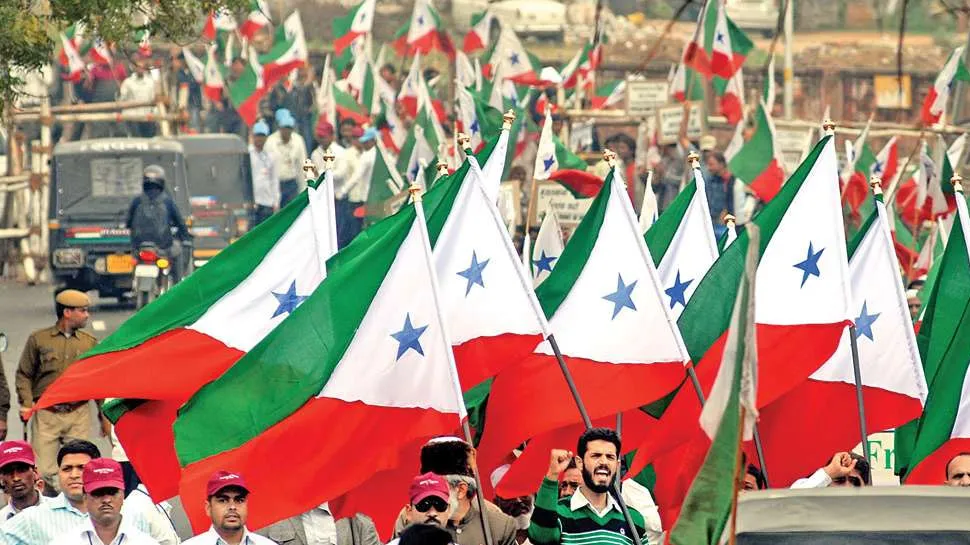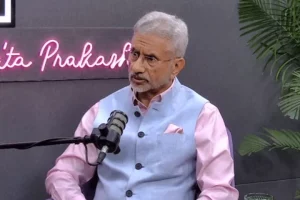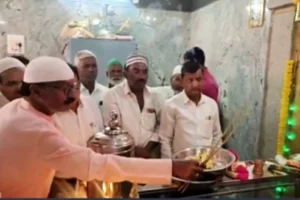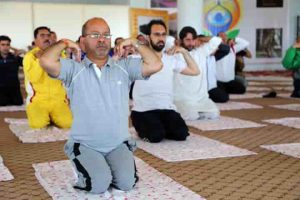The Congress Party’s comparison of Bajrang Dal and the banned Islamist outfit Popular Front of India (PFI) doesn’t come as a surprise. For, a similar preposterous comparison was made by the grand old party in the past with the Rashtriya Swayamsevak Sangh (RSS).
In its manifesto, for the May 10 Karnataka Assembly elections, released on Tuesday the Congress said that if voted to power, it will ban individuals and fundamental organisations like Bajrang Dal and the PFI for spreading hatred.
“We believe that law and Constitution are sacrosanct and cannot be violated by individuals and organisations like Bajarang Dal and PFI or others promoting enmity or hatred,” the manifesto said.
Prime Minister Narendra Modi’s government banned the PFI and its affiliates in September 2022 for five years under the Unlawful Activities (Prevention) Act 1967 for its links with several Islamist terror groups like the banned Students Islamic Movement of India (SIMI), the Jamat- ul- Mujahiddin Bangladesh (JMB) and the Islamic State of Iraq and Syria (ISIS).
Other reasons for banning the PFI include involvement of its members who are accused of murdering RSS worker R Rudresh in broad daylight in Bengaluru in 2016 besides other Hindu activists in other parts of Karnataka.
One wonders how the Congress plans to ban PFI which is already banned by the Centre.
An analysis of the origin, activities, and ideology of the two organisations exposes the false narrative of the Congress.
Bajrang Dal evolved as a youth wing of the Vishwa Hindu Parishad in the mid 1980’s to provide security to participants in the“Sri Ram Janaki Yatra,’’ when the then Uttar Pradesh government refused to provide security. The yatra kickstarted from Ayodhya in 1984 and thousands of Hindu youths joined the amorphous Bajrang Dal. It was much later in the 1990s that the organisation was formalised and brought under the Vishwa Hindu Parishad as its youth wing, says Suryanarayan, national co-convener of Bajrang Dal.
Today, Bajrang Dal has a pan India presence. “Bajrang Dal is not an aggressor. We only fight the aggressors on Hindutva within the framework of the Constitution,’’ he says.
Bajrang Dal works on the principle of “Seva, Suraksha and Sanskar,’’ that is Service, Safety and Culture.
Most often, the news of Bajrang Dal preventing cattle slaughter, love jihad and conversions besides initiating Ghar Vapsi, (convincing families and individuals who were converted to other religions to return to the Hindu fold) gets media attention as we involve police and file cases against violators, he said.
Suryanaran says that Bajarang Dal is not against any religion or religious practices. “We are here to protect the Hindu religion,’’ he asserts.
Bajrang Dal was banned by the late PV Narsimha Rao government at the Centre soon after the Babri Masjid was demolished in 1992. A year later the ban was revoked. The VHP youth wing is neither linked to any terror groups nor involved in any anti-national activities like the PFI, Suryanarayan says.
On the contrary, PFI camouflaged its true colours by wearing different hats to hide its core idea of establishing an Islamic State by joining hands with terror outfits.
*Origin of PFI
After the demolition of a disputed structure at Ayodhya in 1992, an organisation by the name of National Democratic Front (NDF) was created in Kerala, according to Prof Mohyiuddin N Karassery, writer and activist from Kozhikode, Kerala.
Projecting itself as working for socio-economic reforms among Muslims, NDF was pursuing a different agenda altogether.
“In Public domain NDF portrayed itself as an organisation devoted to socio-economic reform work for Muslims, but its extremist and violent nature was exposed when some of its members were arrested for rioting and murdering eight Hindus on Marad beach in Kozhikode in 2003.” (Radicalisation in India, Abhinav Pandya, Pentagon Books, pp 62)
On November 22, 2006, NDF, which was predominantly active in Kerala was merged with Karnataka Forum for Dignity (KFD) and Manitha Neethi Pasarai (MNP) in Tamil Nadu to form PFI. Over a period of three years, several organisations like Goa Citizen’s Forum, Rajasthan’s Community for Social and Educational Society, West Bengal’s Nagrik Adhikar Suraksha Samiti, Manipur’s Lilong Social Forum and Andhra’s Association for Social Justice were also merged with PFI.
Another interesting aspect of PFI is its relationship with the banned outfit SIMI. According to Pandya, “A large number of PFI office-bearers had strong links with SIMI, before it was banned in 2001.”
Prof Karassery also traces the origin of PFI and its political wing SDPI to SIMI, which believed in engineering an Islamic Revolution like in Iran. During a conversation with this correspondent a few years ago he had said that “PFI and SDPI never believed in democratic process.’’
Although PFI remained very active in Kerala, it had its presence in 23 States at the time of the ban in 2022. Two other units of the Front are All India Imam Council (Religious Scholars’ unit) and Satya Sarini, an educational and charity organisation based in Malappuram, actively engaging in conversions, says Jawaharlal Nehru University (JNU) based scholar Soumya Awasthi in a research paper prepared by her on PFI in 2020
“The PFI’s ultimate goal is to replace the democratic system of India with an Islamic State-styled government. The Popular Front of India (PFI)… calls India its enemy and asks for ‘total Muslim empowerment’…. The PFI runs projects like ‘School Chalo’ to encourage education for all up to the secondary level, as well as the ‘Sarva Siksha Gram’ and ‘Adopt a student’ campaigns. These campaigns and projects not only provide them legitimacy to function openly but also provide them cover over their actual missionary work. The PFI’s members believe that India is a democratic country. The doctrine is that slowly they (government of India) are reaching for our necks because of (political and social reasons). PFI members believe that if their rights are breached, then they will be left with no choice but to react — and their holy text provides for a jihad, which they will not be reluctant to utilise and justify their acts (sic), ” she observed.
*Modus Operandi
Detailing the modus operandi of the PFI, Awasthi in her paper titled – “Popular Front of India: Understanding the Propaganda and Agenda,’’ observed: “Even though the organisation came into existence aiming for Muslim empowerment, the PFI’s modus operandi has been to showcase the Muslim agenda as a side show. Instead, they keep the issues of vulnerable societies (Women, labourers, farmers, Dalits, Adivasi) at the forefront. This provides them with the cover of a charitable organisation working for the welfare of minorities and weaker sections of society. This is meant to fool the government — and the organisation has managed not to get banned yet.”
“The writings of Syed Abu Ala Maududi, Allam Iqbal and Osama Bin Laden influence PFI members. They have maintained the image of a charitable organisation and worked for the ultimate goal of establishing an Islamic state by converting and spreading fear through terror acts,” Awasthi noted in her paper.
According to her, “Cadres of the banned outfit SIMI are fast regrouping under the banner of the Popular Front of India (PFI). This outfit has expanded its tentacles to the north after carrying out the initial recruitment in South India. The spreading tentacles of the PFI and Social Democratic Party of India (SDPI), the political wing of the PFI, came to light only when its members became influenced by the taqreer (speeches) of Zakir Naik. Interestingly, just days after the IRF was banned, the Kerala-based Islamic fundamentalist organisation PFI organised massive rallies in different parts of the country in support of Zakir Naik. Intelligence sources say there is electronic evidence of increasing interaction between members of these two groups, especially since the IRF (Islamic Research Foundation) ban.”
*Money Laundering
In 2021, the Enforcement Directorate attached 23 bank accounts of PFI. The ED statement issued on June 1, 2021 stated that “it has provisionally attached 23 bank accounts of PFI having collective balance of Rs 59,12,051 and 10 bank accounts of PFI’s front organisation Rehab India Foundation (RIF) having collective balance of Rs 9,50,030 in the ongoing money laundering investigation against PFI and its related organisations.’’
During the course of investigation, the ED found that huge sums of money was deposited in PFI and RFI bank accounts. Sources of some of these depositors were questionable, ED noted adding that Rs 60 crore including cash component of Rs 30 crore were deposited in PFI bank accounts since 2009. Similarly, the agency pointed out that Rs 58 crore money was deposited since 2010.
ED also found that PFI guilty of indulging in money laundering as per Section 3 of the Prevention of Money Laundering Act 2002 by colluding with other associated accused persons.
Investigations also revealed that large sums of money from Gulf countries was secretly sent to India by way of foreign remittances into bank accounts of PFI sympathisers, office bearers, members, their relatives and associates in India. Later the money was transferred to bank accounts of PFI and RFI, the ED noted.
“In this way, the proceeds of crime have been placed, layered & integrated and therefore projected as untainted money in the bank accounts of PFI as well as RIF. This has been done as a part of a larger criminal conspiracy of PFI and its related entities to raise funds within the country and abroad to carry out various unlawful activities which have resulted in the registration of numerous FIRs or complaints against them… and conviction of its members or office-bearers.”
Comparing a religious organisation that believes in the Constitution with an organisation that doesn’t believe in democratic process and is linked to Islamic terror groups is beyond being just preposterous. Such comparisons only help in polarisation and dividing society on religious lines which is detrimental to Sardar Patel’s concept of realising “Ek Bharat, Shrestha Bhart.’’




















